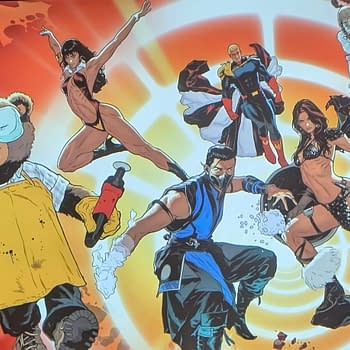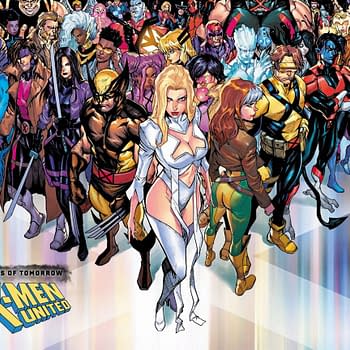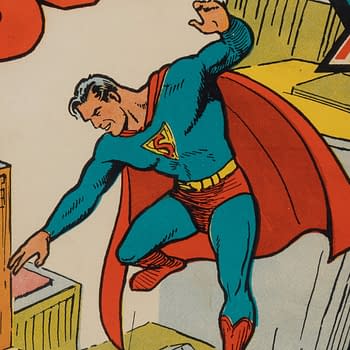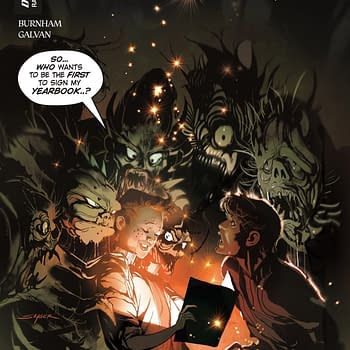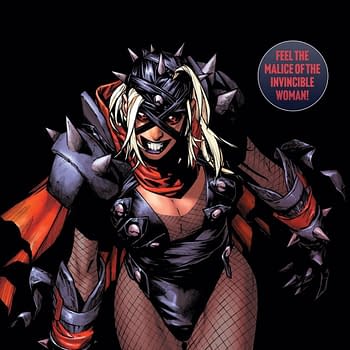Posted in: Comics, Recent Updates | Tagged: Alan Moore, Iain Sinclair, Kevin O'Neill, League of Extraordinary Gentlemen Volume III: Century, top shelf
The League Of Extraordinary Gentlemen Vol. III: Century Makes All The Right Connections
Dave Wallace reviews the League of Extraordinary Gentlemen, Volume III: Century hardcover for BleedingCool:
When Alan Moore and Kevin O'Neill finally wrenched their League of Extraordinary Gentlemen series away from DC Comics, their first step was to change the format of the series completely. The third volume of LOEG was neither a serialised six-part story in the American 'floppy' format, nor a single graphic novel à la Black Dossier: instead, it was a series of three interconnected yet individually standalone 'graphic novellas' that spanned an entire century of time for the League, each of which was set in a specific year: 1910, 1969, and 2009.
Having originally been released years apart, the three-part Century series has now been collected into a handsome single hardcover volume by Knockabout Comics and Top Shelf – and it's a great format in which to enjoy the third volume of the series.
One of the things that you'll notice about Century is the slight change in tone compared to previous volumes. This may still be a book called The League of Extraordinary Gentlemen, but it's not really about the League – or at least, a functioning version of it – instead serving as a wider exploration of the intricate world that Moore and O'Neill have created through their unique literary unified theory.
It's also slower-moving than previous volumes, offering the opportunity for greater depth in terms of its depiction of the characters, and giving the creators the space to explore some slightly more challenging ideas about the nature and value of literature than were raised in the earlier books.
Focusing on newly-introduced characters as much as the old favourites, and assuming a certain level of knowledge on the part of the reader (there are very few obvious recaps of characters' histories or motivations here), it feels like a book that has been liberated from the requirements of being a DC comic, and can actually be written for the attentive audience it deserves.
That said, Century still feels very much of a piece with the earlier LOEG adventures, and plays an important role in broadening the horizons of the world of the League – not least by introducing all manner of new guest-characters to the series' mythos, with my personal favourite being Andrew Norton from Iain Sinclair's Slow Chocolate Autopsy, whose enigmatic utterances play a key role throughout all three chapters.
As ever, Moore's careful treatment of even minor supporting characters reinforces the writer's love of fiction in all its forms – even if, by the time the book's ultimate climax rolls around, you could be forgiven for questioning that love. Because the denouement of Century is one of the darkest, most challenging sequences in the series to date, obliquely articulating certain criticisms towards modern fantasy literature that some readers may find hard to swallow.
O'Neill's contribution to the series should never be underestimated, and he provides some of the standout moments here: in particular, the artistic experimentation during the climax of the '1969' middle chapter stakes out bold new territory for LOEG, with a psychedelic colour palette and unusual, non-linear page layouts helping to evoke some occasionally-disturbing imagery as the series begins to veer into darker territory. There's also a stunning earlier sequence in which Janni Dakkar launches a dockside attack, offering explosive action on a grand scale in the way that only great comics can pull off.
The artist is also great at bringing less showy moments to the page, with a command of body language and facial expressions that – despite O'Neill's angular, unnatural-looking style – manages to sell the reality of (say) a low-key dialogue exchange or a moment of physical closeness between two characters just as effectively as could several pages of Moore's prose.
The only real criticism I have of O'Neill is his occasional tendency to overwhelm the visuals by packing in multiple cameos and 'easter eggs', but given how much entertainment and delightful recognition these references provide, I think you can forgive the occasional crowded panel.
Yes, one could argue that Century is neither as original in concept as the early volumes of LOEG nor as innovative as the multi-media explosion of Black Dossier – but the third proper volume of the series is nonetheless an excellent and essential part of the story of the League, and one that is certainly done justice by this smart hardcover edition. Especially since having all three books in one volume helps you to more easily see the connections between the trio of temporally-separated narratives, which were originally published so far apart that the through-lines that connected them weren't always readily apparent.
Talking of this hardback specifically, the book is well worth an upgrade for those who might own the original three paperback editions of Century, as it includes a few extras that weren't part of those volumes. These include special full-page 'bookplate' images by O'Neill (one for each chapter) that were originally available only in limited editions, as well as a couple of pieces of promotional art that were never used in the books themselves, and a new cover drawn by the artist for an Italian collection of the series.
And all three of the backup text stories from the original Century publications are also collated here, providing a comprehensive and uninterrupted rundown of the lunar exploits of Mina and the Galley-Wag. Like the main stories themselves, they're presented here as one continuous whole: and after enjoying them all over again in this new edition, I have to conclude that this hardcover is the definitive way in which to enjoy League of Extraordinary Gentlemen, Volume III: Century.
League of Extraordinary Gentlemen, Volume III: Century is released July 17th from Knockabout Comics and Top Shelf.











